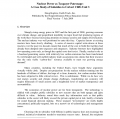Nuclear Power as Taxpayer Patronage: A Case Study of Subsidies to Calvert Cliffs Unit 3

A case study of the proposed new reactor at Calvert Cliffs in Lusby, MD provides a useful window into the dynamics and implications of federal nuclear policy today. The analysis demonstrates not only that the taxpayer ends up as the largest de facto investor in this project, but also that while we bear most of the downside risk, we share little of the upside should the plant ultimately be successful. The data also highlight that despite nuclear's relatively low carbon footprint, the cost per unit greenhouse gas avoided is far more expensive than many other alternatives.
This paper begins with some historical context on the role of government subsidies to nuclear power in the United States. It then shifts to the specific case of Calvert Cliffs, including the venture structure, projected costs, and acknowledged or embedded subsidies. The final sections of the paper evaluate the cost-efficiency of a nuclear power option to address energy security and global warming concerns.
Forthcoming in Expanding Nuclear Power: Weighing the Costs and Risks, Henry Sokolski, editor. (Carlisle, PA: Strategic Studies Institute).

